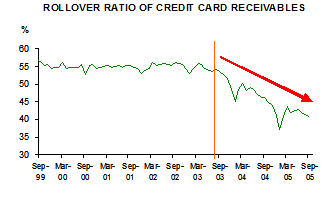Positive credit data sharing has brought demonstrable benefits to consumers.
Three years ago, the HKMA, together with the banking sector, lobbied strongly for allowing consumers' positive credit data to be shared by credit providers. One of the objectives was to address the rapidly deteriorating bankruptcy problem at that time. The Privacy Commissioner, after extensive consultation, finally endorsed the proposal with two conditions. First, in order to prevent a credit crunch, there would be a two-year moratorium during which credit providers would not be allowed to access the credit data of their existing customers. Secondly, the HKMA had to reach a consensus with the Consumer Council on how to implement the policy. As part of this consensus, which was duly reached, the HKMA undertook to monitor and assess the benefits of positive data sharing to consumers. The first assessment was to be made after the expiry of the moratorium in June 2005. We have now completed the first assessment.
Before the assessment, we wondered whether the moratorium would delay the expected benefits to consumers. The assessment results suggest that, even if it did, the delay was not significant.
Between the start of positive data sharing in August 2003 and September 2005, credit card receivables increased by nearly 10% from $54 billion to $59 billion. This is not surprising in view of the improving economy. What is interesting is that the "rollover amounts", meaning the borrowing which the cardholders have not fully repaid (but in respect of which they have at least paid the minimum amount required by the card issuers) fell by 17% from $29 billion to $24 billion during the same period. The "rollover ratio", meaning the percentage of rollover amounts to the total amount of card receivables, took a big dive from 54% to 41%. The following chart demonstrates the significance of the decline compared with the position before positive credit data sharing.

Meanwhile, non-card credits, meaning the unsecured credits other than credit cards extended by financial institutions (including non-authorized institutions) to individuals, increased by 38% from $29 billion to $40 billion1 from December 2003 to December 2005. Clearly a large amount of credit card rollovers had been substituted by non-card credits during the period, and this trend has continued since then.
Another interesting phenomenon is the changes in the non-card credit market. This market, unlike the one for credit cards, which is dominated by banks, involves many non-bank financial institutions. The market share of these non-bank players increased from 25% to 30% between December 2003 and December 2005. Apparently, as confirmed by our interviews with these institutions, they have been spearheading the substitution. These smaller institutions were not burdened with big existing loan portfolios. They could therefore take advantage of the moratorium and act aggressively to offer loans to consumers for paying off their credit card debts at much lower interest rates. Positive data sharing has enabled them to do this. Without these data, they would not have been able to manage and price their risks.
It is impossible to quantify the interest saved by consumers as a result of these market developments because some of the major lenders in the non-card credit market are not authorized institutions and we do not have the power to collect detailed data from them. However, a very large amount of credit card rollovers has apparently been substituted by non-card credits with significant interest rate differentials (6-10% according to the market). On the other hand, the average interest rate for the remaining credit card rollovers has remained more or less flat. Overall, the interest savings for consumers are likely to be substantial.
Now that the moratorium is over, there are signs that banks and the bigger financial institutions are fighting back. There are also new players joining the consumer credit market. I believe this is good news for consumers because they are likely to benefit from more competition.
The moratorium was a necessary arrangement designed to moderate the working of market forces for a time. Still, the market is moving in the right direction, at least as far as consumer benefits are concerned. The pace of the market change might have been slowed and the route more convoluted than otherwise, but consumers still stand to gain.
Joseph Yam
9 February 2006
1Statistics provided by TransUnion Information Services Ltd.
Related Viewpoint Article:
Click here for previous articles in this column.
Document in Word format


